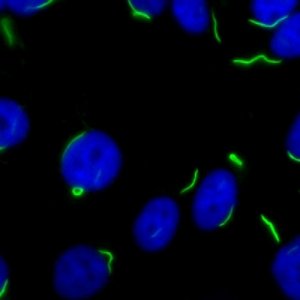☘️Antinuclear Antibodies...

Highlights
- ☘️Antinuclear Antibodies (ANA)☘️ -Part ✌️
We learnt about the history and lab methods in part ☝️
https://t.co/m7myleJD2I
Let's continue the story!!
#RheumTwitter #MedEd #MedTwitter #rheumatology
(1/24)
 (View Tweet)
(View Tweet)
- The biggest advantage of indirect immunofluorescence is the ability to gauge antibody specificity from the staining pattern
Prerequisites
🔹An experienced professional
🔹+ & - controls
(2/24) (View Tweet)
- 1️⃣👀 at the uniform staining & staining of the dividing cells(🔺) associated with Ab to histone, nucleosome & dsDNA– characteristic of #lupus 🦋
(3/24)
 (View Tweet)
(View Tweet)
- 2️⃣Next, a beautiful pattern
Clue: Classic of Limited Systemic Sclerosis
(4/24)
 (View Tweet)
(View Tweet)
- Any guesses?
(5/24) (View Tweet)
- It's indeed centromere pattern!
Note the discrete speckles (40-80/cell) with intense staining of the metaphase end plate(🔺)
Classic of Limited #Scleroderma
(6/24) (View Tweet)
- 3️⃣More speckling throughout the nucleoplasm 🫥
(7/24)
 (View Tweet)
(View Tweet)
- What's this pattern called?
(8/24) (View Tweet)
- It's fine speckled!
Fine, numerous speckled throughout the nucleoplasm +/- nucleolar staining
Classic of anti SSA, SSB Ab & some more (Mi2 TIF1y and Ku !)
(9/24) (View Tweet)
- 4️⃣Next🔬
Speckles again but they are coarse this time!
Can you tell me the associated antibodies?
(10/24)
 (View Tweet)
(View Tweet)
- Select the ✅ combination
(11/24) (View Tweet)
- The correct answer is 3!!
5️⃣Next🔬📷
homogenous?
centromere?
Or just speckled?
This pattern is called 'diffuse fine speckled/DFS' associated with anti-DFS70 Ab
Note the speckled staining of the nucleoplasm
(12/24)
 (View Tweet)
(View Tweet)
- How is DFS different from FS?
Look at the coarse speckled staining of the metaphase end plate(🔺)!
It can be confused with homogenous pattern too, looking at the 🐀 liver helps!
This Ab is negatively associated with autoimmune disease
🔔🔔🔔 +ANA🚫=autoimmunity
(13/24) (View Tweet)
- 6️⃣Another pretty one!
Which pattern X antibody combination is the correct one??
- Multiple nuc dots a) PmScl
- Coarse speckled b) NXP2
- Nucleolar c) fibrillarin
(14/24)
 (View Tweet)
(View Tweet)
- Think carefully!
(15/24) (View Tweet)
- It's 1b!
6-20 discrete dots in the nucleoplasm is classic of multiple nuclear dots......
7️⃣ This🔬📷 shows staining of the nucleoli (3-5/ nucleus)
Classic of all these Ab:
🔹Pm/Scl
🔹Th/to
🔹Fibrillarin
🔹RNA pol I
(16/24)
 (View Tweet)
(View Tweet)
- All the above were nuclear patterns ☢️
We can also have cytoplasmic staining- often in idiopathic inflammatory myopathies especially antisynthetase syndrome ☘️
(17/24)
 (View Tweet)
(View Tweet)
- We've left out one other important pattern that is a combination pattern 🍹
🔹Speckled nucleoplasm
🔹Metaphase chromosomal staining🔺+ staining of the NOR ⭕
🔹Cytoplasmic staining↗️
🔹+- nucleolar staining
⭐ anti topoisomerase/Scl70 in diffuse systemic sclerosis ⭐
(18/24)

 (View Tweet)
(View Tweet)
- & then some patterns are just nice to know !!
Tell me which one are these?
(19/24)

 (View Tweet)
(View Tweet)
- The ✅ combination is:
(20/24) (View Tweet)
- ✅ answer ☝️is 1.
Now, is a positive ANA enough to start thinking of autoimmune diseases?
Or a negative ANA enough to rule them out??
Of course not! 🚫🙅❌
(21/24) (View Tweet)
- Remember, healthy individuals can also have a positive ANA!!
Other autoimmune diseases (as common as hashimoto's thyroiditis, ITP) can also have a positive ANA
#MedTwitter
#MedEd
(22/24)
 (View Tweet)
(View Tweet)
- Other common causes
Malignancies: most common hematologic like multiple myeloma
Infections: infective endocarditis, chronic– HIV, tuberculosis, Hansen's, acute viral infections
(23/24) (View Tweet)
- Lastly, myositis and most vasculitic syndromes are two important systemic autoimmune diseases which may not have a positive ANA!
Most important bottom line: Clinical correlation is the 🗝️!
Further reading:
https://t.co/umzZxebzSr…
https://t.co/9YnxMUOsZn
(24/24) https://t.co/QuGUyFGKKM (View Tweet)

 (View Tweet)
(View Tweet) (View Tweet)
(View Tweet) (View Tweet)
(View Tweet) (View Tweet)
(View Tweet) (View Tweet)
(View Tweet) (View Tweet)
(View Tweet) (View Tweet)
(View Tweet) (View Tweet)
(View Tweet) (View Tweet)
(View Tweet)
 (View Tweet)
(View Tweet)
 (View Tweet)
(View Tweet) (View Tweet)
(View Tweet)